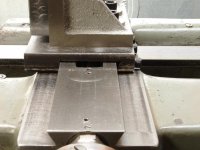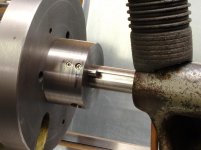jockofthelowveld
Hot Rolled
- Joined
- Jan 25, 2008
- Location
- Blythewood, S.C.
Follow along with the video below to see how to install our site as a web app on your home screen.
Note: This feature may not be available in some browsers.



 More photos:
More photos:So for making the support that is riding on the carriage, did you machine that bore for the bearing in place, using the lathe as a HBM, or take it to a different machine?
I suspect rigidity. The apron is meant to be slid/driven under load, unlike the tail stock.Why not hold the bar, and move the tailstock?
allan
Why not hold the bar, and move the tailstock?
allan
I suspect rigidity. The apron is meant to be slid/driven under load, unlike the tail stock.
Very nice work, OP.
But, why not hone the TS bore?


 Jim;
Jim;That's some sweet stuff.
I do recall reading that if you had made the
bar out of, say, hot rolled steel then it would
not move when the slot was cut along its length.
I'm interested to see how the liner will be finished on the
inside to accept the tailstock quill. Will you be using
the original quill or making a new one?
This is a very challenging job - after you iron out all the
details I bet you could get a long line of customers who
want it done for their machine!
I am very interested in this as I have 2 tailstocks that need a lot of attention. I have been pondering how to go about tackling them.

Wow. That's about all I can say. And great photos. I have a similar problem on the tailstock on my Clausing 5914, and the elegance of this solution is very attractive - but when I think about the effort involved, it just makes me want to take a nap. ;-)
I am curious about why so much stock removal was performed on the tailstock casting. Was this done simply to allow the sleeve to be somewhat more robust, and maybe easier to make? I note that you have increased the TS spindle diameter, which goes with the other feature changes, but just wondering what drove the decisions.
Notice
This website or its third-party tools process personal data (e.g. browsing data or IP addresses) and use cookies or other identifiers, which are necessary for its functioning and required to achieve the purposes illustrated in the cookie policy. To learn more, please refer to the cookie policy. In case of sale of your personal information, you may opt out by sending us an email via our Contact Us page. To find out more about the categories of personal information collected and the purposes for which such information will be used, please refer to our privacy policy. You accept the use of cookies or other identifiers by closing or dismissing this notice, by scrolling this page, by clicking a link or button or by continuing to browse otherwise.
